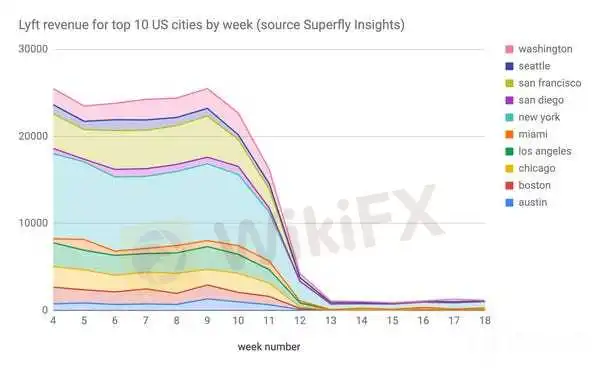简体中文
繁體中文
English
Pусский
日本語
ภาษาไทย
Tiếng Việt
Bahasa Indonesia
Español
हिन्दी
Filippiiniläinen
Français
Deutsch
Português
Türkçe
한국어
العربية
Lyft earnings: First look at just how bad coronavirus impact has been - Business Insider
Abstract:Unlike Uber, Lyft has been tight-lipped about just how bad its rides business has been hurt — and it doesn't have a food-delivery arm to ease losses.
Lyft is set to report its first-quarter financials on Wednesday. It's the first look investors and analysts will have into the coronavirus' impact on the ride-hailing firm. In recent weeks, Lyft has cut jobs and withdrawn its forecast for the year, but hasn't hinted at how bad things might be. Visit Business Insider's homepage for more stories.
Lyft is set to unveil its first-quarter financial performance on Wednesday afternoon, offering investors and the public their first look at the impact the coronavirus is having on the No.2 ride-hailing firm.Unlike Uber, which has disclosed some details about the dropoff in its core ride business, Lyft has remained relatively quiet aside from withdrawing its 2020 guidance.Here's what Wall Street is expecting from Lyft for the first-quarter, of which only the final weeks were impacted by the full force of the coronavirus:Revenue: $829.6 millionNet loss (adjusted): $179.6 millionLosses per share (adjusted): $0.64
Ride-hailing has been hit hard by shelter-in-place orders around the world, and Lyft is no exception.Data from SuperFly, a firm that tracks anonymized spending data from 2 million users, showed Lyft revenue sinking to about 10% of its revenues earlier in the year. The impact could be even greater on Lyft's second-quarter, with no meaningful uptick yet detected in SuperFly's data.

SuperFly
And while Lyft doesn't have a delivery arm as large as Uber's to make up for some of the ride-hailing losses, its limited global footprint of only North America could prove to be a positive in the long run.“As Uber is exposed to earlier-hit markets in Europe and Asia, we expect demand for the company to have been more greatly impacted than Lyft in 1Q20E,” Dan Ives of Wedbush told clients Wednesday. “Given Uber's greater exposure to business and airport travel use cases, we also expect that the company will see a relatively greater flow-through impact on revenue, with a Y/Y contraction of -41% in Rides revenue vs. -17% for Lyft.”
In order to cut costs, Lyft announced in April it would lay off nearly 1,000 employees, or roughly 17% of its total headcount. Executives and high-level employees are also taking pay cuts.“It is now clear that the COVID-19 crisis is going to have broad-reaching implications for the economy, which impacts our business,” CEO Logan Green said in a press release at the tine. “We have therefore made the difficult decision to reduce the size of our team. Our guiding principle for decision-making right now is to ensure we emerge from the crisis in the strongest possible position to achieve the company's mission.”On the call following Wednesday's earnings release, company leadership will likely be pressed for insight into the effect of such cost-cutting. Lyft's market value has been cut in half since February as the coronavirus pandemic catalyzed a larger market selloff.“Uber and Lyft face Herculean-like challenges looking ahead as the new reality will likely change the business models of these companies (and competitors) for the foreseeable future,” Ives said in his note to clients. “Even in food delivery while consumer demand is there, competition is driving meaningful pressure on profitability.”
Loading
Something is loading.
Disclaimer:
The views in this article only represent the author's personal views, and do not constitute investment advice on this platform. This platform does not guarantee the accuracy, completeness and timeliness of the information in the article, and will not be liable for any loss caused by the use of or reliance on the information in the article.
Read more

GEMFOREX - weekly analysis
The week ahead: 5 things to watch.
Fed survey: The poorest Americans are being hit hardest by job loss - Business Insider
"This reversal of economic fortune has caused a level of pain that is hard to capture in words," said Fed Chair Jerome Powell.
12 people who seemingly predicted the coronavirus pandemic - Business Insider
Bill Gates warned Donald Trump before he took office of the dangers of a pandemic — and urged him to prioritize the US' preparedness efforts.

US jobless claims preview: Economists expect another week of decline - Business Insider
"If the current rate of decline continues, claims will dip below 1M in the second or—more likely—third week of June," said economist Ian Shepherdson.
WikiFX Broker
Latest News
Geopolitical Events: What They Are & Their Impact?
Top 10 Trading Indicators Every Forex Trader Should Know
ASIC Sues Binance Australia Derivatives for Misclassifying Retail Clients
WikiFX Review: Is FxPro Reliable?
Malaysian-Thai Fraud Syndicate Dismantled, Millions in Losses Reported
Trading frauds topped the list of scams in India- Report Reveals
Why Do You Feel Scared During Trade Execution?
WikiFX Review: Something You Need to Know About Markets4you
Revolut Leads UK Neobanks in the Digital Banking Revolution
Fusion Markets: Safe Choice or Scam to Avoid?
Currency Calculator


